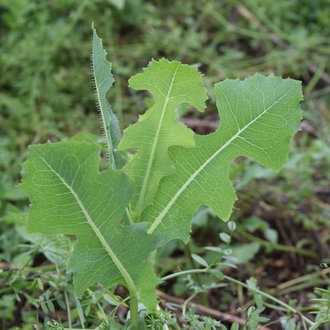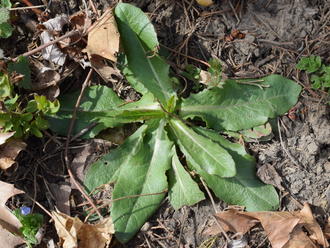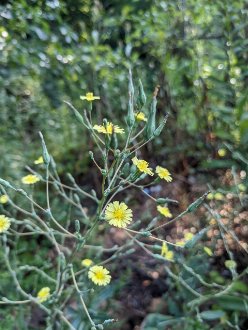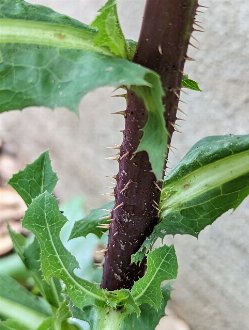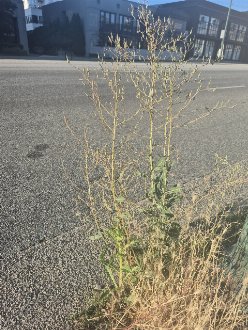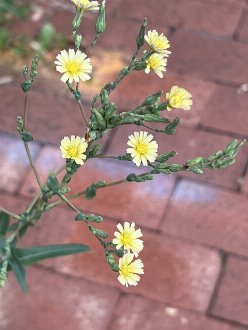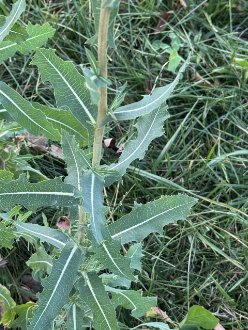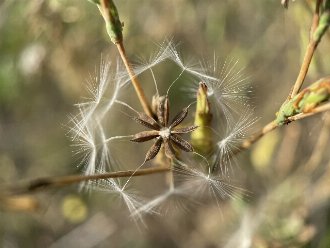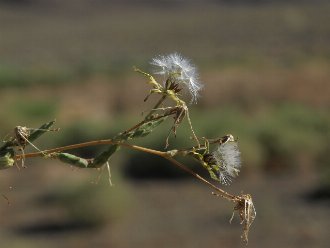Prickly Lettuce (Lactuca serriola L.)
↑Summary
An annual native to Europe, Asia, and North Africa, introduced to North America where it is often considered invasive.
↑Description & Identification
This plant is highly variable in its growth habit, size, leaf shape, and other structures. Can grow up to 7' but usually much shorter. Leaves are alternate and clasping the stem at the base, variably lobed, ranging from unlobed to deeply cut with many lobes. Leaf margins are prickly, and prickles also run along the central vein. Unlike thistles, prickles are not usually stiff enough to puncture skin. The density of prickles is highly variable, ranging from dense to sparse; prickles tend to be densest in arid, wild habitats where pressure from herbivory is most intense. Leaves and stem both emit a milky white sap when cut.
Usually has a taproot that proceeds straight downward when soil structure allows.
↑Similar Plants
↑Habitat
Prefers full sun and tolerates only light shade; found in soils ranging from rich soils on mesic sites to dry, nutrient-poor soil.
In most of eastern North America, found only on disturbed ground in anthropogenic habitats, including roadsides and railroads, gardens, abandoned fields, and waste ground. In more arid areas in the southwestern US and Mexico, it is still most common in anthropogenic habitats, but more likely to be found in wild areas, including riparian areas and scrubland.
↑Life Cycle
Prickly lettuce is an annual or biennial, in the sense that it sometimes blooms during the same year it germinates, but sometimes grows only as a basal rosette of leaves during the first year. Which happens depends both on timing of seed germination, and conditions.
Plants establish a taproot upon sprouting. Basal rosettes grow flat to the ground in winter; in spring, they take on a more rounded, bushy growth habit, and they begin to bolt upward late spring to early summer.
Usually blooms mid-summer, sometimes later.
Produces wind-dispersed seeds; plants die after setting seed. Seeds have no required dormancy period and most germinate in fall, within a couple weeks of being distributed. A small portion of seeds overwinter and germinate in spring, with an even smaller portion forming a short-term seed bank, which is exhausted after 3 years.
This plant usually depends on disturbance to remain present in an area.
↑Control
This plant is generally easy to control by manually uprooting any time before it produces seeds, but it tends to be easier to pull the younger it is, so learning to identify young plants is helpful.
Gloves are helpful for pulling all but the youngest seedlings, and a trowel or shovel can be necessary for larger plants with robust root systems. Mature plants tend to have a thick, fibrous root system that will often bring a large amount of attached soil with it if the plant is uprooted. Care must be taken to minimize soil disturbance if uprooting large plants.
For large infestations or if pulling is impractical without causing too much soil disturbance, seed production can be reduced with less effort and no disturbance to soil by clipping off plants low the the ground, around the time of flowering but before the plants set seed. Plants may try to resprout and bloom, but seed production will be greatly reduced and may fail entirely.
Herbicides tend to be poor at controlling this plant, and widespread, casual herbicide use may actually favor its dominance. It is highly resistant to many herbicides, including glyphosate and dicamba, as well as selective herbicides such as 2,4-D and MCPA. Plants growing an upright stem in particular have low leaf surface area relative to the plant's total extent, and a waxy leaf coating that minimizes herbicide absorption.
↑Uses
This species has sometimes used for producing Lettuce Opium or Lactucarium, a sedative milder than opiates, although the closely-related Lactuca virosa is more often used for this purpose.
↑Related Plants
Lactuca serriola is closely related to cultivated lettuce (Lactuca sativa), and can hybridize with it.
There are also numerous Lactuca species native to North America, as well as other introduced species; L. serriola is the most abundant introduced lettuce in most of North America. In terms of its ecological niche, it is probably most similar to L. canadensis, which grows taller and is slightly more shade-tolerant.
↑Links & External Resources
• Lactuca serriola (Prickly Lettuce) | Illinois Wildflowers (About This Site)
• Lactuca serriola (Prickly Lettuce) | USDA PLANTS Database (About This Site)
• Lactuca serriola | Go Botany (About This Site)
• Lactuca serriola | Biota of North America Project (BONAP) (About This Site)
• Lactuca serriola | NatureServe Explorer (About This Site)
• Lactuca serriola | Flora of North America (About This Site)
• Lactuca serriola | Missouri Plants (About This Site)
• Prickly Lettuce | Maryland Biodiversity Project (About This Site)
• Lactuca serriola (Prickly Lettuce) | Minnesota Wildflowers (About This Site)
• Lactuca serriola L. (Prickly Lettuce) | Digital Atlas of the Virginia Flora (About This Site)



